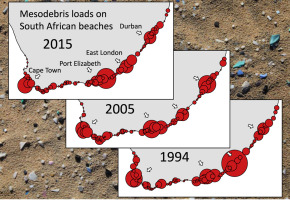Environmental Pollution ( IF 7.6 ) Pub Date : 2018-02-16 , DOI: 10.1016/j.envpol.2018.02.017 Peter G. Ryan , Vonica Perold , Alexis Osborne , Coleen L. Moloney

|
Identifying the sources of small plastic fragments is challenging because the original source item seldom can be identified. South Africa provides a useful model system to understand the factors influencing the distribution of beach litter because it has an open coastline with four equally-spaced urban-industrial centres distant from other major source areas. We sampled mesodebris (∼2–25 mm) at 82 South African beaches in 1994, 2005 and 2015. Plastic items comprised 99% by number and 95% by mass of litter items. Industrial pellets were the most abundant plastic items, but fragments of rigid plastic items comprised most of the mass of debris. Strong correlations between industrial pellets and other plastic items indicate that common factors influence the distribution of both pellets and secondary mesoplastics. The abundance of mesodebris at beaches also was correlated in successive surveys, suggesting that beach-specific factors (e.g. aspect, slope, local currents, etc.) influence the amounts of debris on each beach. Sample year had no effect on mesodebris abundance, indicating that there has been little change in the amounts of mesodebris over the last two decades. There were consistently higher densities of both industrial pellets and other plastic items at beaches close to urban-industrial centres; there were only weak correlations with human population density and no correlation with local runoff. The size of industrial pellets decreased away from local urban centres, further supporting the conclusion that, like macroplastic litter, most mesoplastic pollution on continental beaches derives from local, land-based sources. This finding means that local actions to reduce plastics entering the sea will have local benefits, and that it may be possible to assess the efficacy of mitigation measures to reduce marine inputs of mesoplastic items.
中文翻译:

南非海滩上的碎屑呈一致趋势,表明工业颗粒和其他中塑性物质主要来自当地来源
识别小塑料碎片的来源具有挑战性,因为很少可以识别原始来源项目。南非提供了一个有用的模型系统,以了解影响沙滩垃圾分布的因素,因为它拥有开放的海岸线,并且四个等距的城市工业中心远离其他主要来源地区。我们在1994年,2005年和2015年在82个南非海滩上取样了中胚层(约2-25毫米)。塑料制品的数量占99%,垃圾质量占95%。工业颗粒是最丰富的塑料物品,但是硬质塑料物品的碎片占了大部分碎片。工业颗粒与其他塑料制品之间的强相关性表明,共同因素会影响颗粒和次生中塑料的分布。在连续的调查中,海滩的中胚层含量也相关联,表明海滩特定因素(例如,坡度,坡度,局部水流等)会影响每个海滩上的碎片数量。样本年份对中胚层的丰度没有影响,表明在过去的二十年中中胚层的数量几乎没有变化。在靠近城市中心的海滩上,工业颗粒和其他塑料制品的密度一直较高;与人口密度的相关性很小,与当地径流的相关性很小。工业颗粒的尺寸远离本地城市中心而减小,这进一步支持了这样的结论,即像大型塑料垃圾一样,大陆海滩上的大多数中塑性污染源于当地的陆上来源。











































 京公网安备 11010802027423号
京公网安备 11010802027423号